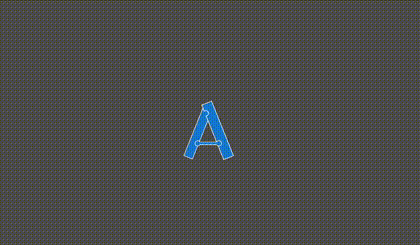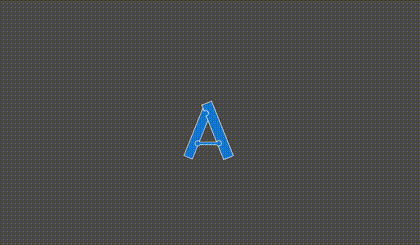AnimaNode
Usage
This node is used to handle the setup of all the animations supported by the addon. There are two ways you can use it:
- By manually adding the node to your scene
- Via gdscript
1. Manually added to the scene
Suppose we have added the node to our scene and its name is "AnimaNode" now we can access its functionality with, for example:
$AnimaNode.then( Anima.Node($node).anima_animation("tada", 0.7) ).play()
2. Gdscript way
To add the node programmatically via gdscript you have to invoke the begin or begin_single_shot function first:
Anima.begin(self) \
.then( Anima.Node($node).anima_position_x(100, 0.3) ) \
.play()
# OR
Anima.begin_single_shot(self) \
.then( Anima.Node($node).anima_position_x(100, 0.3) ) \
.play()
Signals
animation_started
Emitted when the animation or loop starts
signal animation_started
animation_completed
Emitted when the animation or loop starts
signal animation_completed
loop_started
Emitted when a loop starts
signal loop_started(loop_count: int)
loop_completed
Emitted when a loop completes
signal loop_completed(loop_count: int)
Methods
- then(AnimationDeclaration)
- with(AnimationDeclaration)
- wait(delay)
- play()
- play_with_delay(delay)
- play_with_speed(speed)
- play_backwards(delay)
- play_backwards_with_delay(delay)
- play_backwards_with_speed(speed)
- stop()
- clear()
- set_visibility_strategy
- set_loop_strategy()
- get_length()
- set_default_duration
Reference
then: sequential animations
The then method allows you to animate elements in a sequence.
Syntax
then( data: AnimaAnimationDeclaration )
Example

Anima.begin_single_shot(self, 'sequential') \
.then( Anima.Node($Logo).anima_position_x(100, 1) ) \
.then( Anima.Node($Logo).anima_position_y(80, 1).anima_delay(-0.5) ) \
.then( Anima.Node($Logo).anima_rotate(90, 1).anima_delay(0.5) ) \
.play()
Timeline
When we play this animation, we can see the node moving in diagonal after about 0.5s, and for about 0.5s, as we used a negative delay to the 2nd animation:
with: parallel animations
The with method allows you to animate elements in parallel.
Syntax
with( data: AnimationDeclaration )
Example

Anima.begin(self, 'parallel') \
.then( Anima.Node($Logo).anima_position_x(100, 1) ) \
.with( Anima.Node($Logo).anima_position_y(80, 1) ) \
.with( Anima.Node($Logo).anima_rotate(90, 1) ) \
.play()
clear
Clears all the animations.
Syntax
anima.clear()
get_length
Returns the total animation duration.
Syntax
anima.get_length()
set_visibility_strategy
This method allows hiding all the nodes that will be animated when the animation hasn't started yet. Let's have a look at the following gif:
we have three elements:
- Window
- Text
- Button
We want all of them hidden for this kind of animation when it has not started yet. A simple solution can hide them in the editor; it works. But I always end up forgetting to re-hide stuff after doing some test. So this method is helpful to avoid this kind of distraction, as we can specify, during the creation of the animation, that we want to hide :)
Syntax
set_visibility_strategy(strategy: Anima.VISIBILITY, always_apply_on_play := true)
| Param | Type | Description |
|---|---|---|
| strategy | int | The visibility strategy to apply |
| always_apply_on_play | bool | If true re-apply the visibility strategy every time .play() is called |
Visibility Strategies
| Strategy | Description |
|---|---|
| Anima.Visibility.IGNORE | Leaves everything as it is |
| Anima.Visibility.HIDDEN_ONLY | Hides the element using the .hide() method |
| Anima.Visibility.TRANSPARENT_ONLY | Sets the modulate alpha channel to 0 |
| Anima.Visibility.HIDDEN_AND_TRANSPARENT | Hides and makes the elements transparent |
TRANSPARENT and HIDDEN have a different impact on the node:
- A transparent node can still receive the focus and click events. So, a button will still show the hand cursor when hovered. But it will keep the space occupied
- A HIDDEN node cannot be clicked and does not occupy any space. So this means that when made visible, it will claim its space, and you might experience other elements being pushed to a different position.
Example
func _ready():
Anima.begin(self, 'sequence_and_parallel') \
.set_visibility_strategy(Anima.Visibility.TRANSPARENT_ONLY) \
.then( Anima.Node($Panel).anima_animation( "scale_y", 0.3 ) ) \
.then( Anima.Node($Panel/MarginContainer/Label).anima_animation( "typewrite", 0.3 ) ) \
.then( Anima.Node($Panel/CenterContainer/Button).anima_animation( "tada", 0.5 ).anima_delay(-0.5) ) \
.play_with_delay(0.5)
loop
Loops the animation # given times.
NOTE: By default Anima will not re-calculate the relative data. See set_loop_strategy for more information.
Syntax
anima.loop(times: int = -1)
| Param | Type | Description |
|---|---|---|
| times | int | Number of loops to execute. Use -1 to have an infinite loop. |
loop_with_delay
Loops the animation # given times with an interval of # seconds between each loop
Syntax
anima.play_with_delay(delay: float, times: int)
| Param | Type | Description |
|---|---|---|
| delay | float | Delay before starting a new loop. NOTE it is not applied for the first loop |
| times | int | Number of loops to execute. Use -1 to have an infinite loop. |
Example
Anima.begin(self, 'sequence_and_parallel') \
.then( Anima.Node($Panel).anima_animation( "scale_y", 0.3 ) ) \
.then( Anima.Node($Panel/MarginContainer/Label).anima_animation( "typewrite", 0.3 ) ) \
.then( Anima.Node($Panel/CenterContainer/Button).anima_animation( "tada", 0.5 ).anima_delay(-0.5) ) \
.set_visibility_strategy(Anima.Visibility.TRANSPARENT_ONLY) \
.loop_with_delay(0.5, 5)
Loops the animation 5 times and applies a delay of 0.5 seconds from the 2nd loop.
loop_backwards
Loops the animation backwards X given times.
NOTE: By default Anima will not re-calculate the relative data. See set_loop_strategy for more information.
Syntax
anima.loop_backwards(times: int = -1)
| Param | Type | Description |
|---|---|---|
| times | int | Number of loops to execute. Use -1 to have an infinite loop. |
loop_backwards_with_delay
Loops the animation backwards X given times with an interval of Y seconds between each loop
Syntax
anima.play_backwards_with_delay(delay: float, times: int)
| Param | Type | Description |
|---|---|---|
| delay | float | Delay before starting a new loop. NOTE it is not applied for the first loop |
| times | int | Number of loops to execute. Use -1 to have an infinite loop. |
Example
Anima.begin(self, 'sequence_and_parallel') \
.then( Anima.Node($Panel).anima_animation( "scale_y", 0.3 ) ) \
.then( Anima.Node($Panel/MarginContainer/Label).anima_animation( "typewrite", 0.3 ) ) \
.then( Anima.Node($Panel/CenterContainer/Button).anima_animation( "tada", 0.5 ).anima_delay(-0.5) ) \
.set_visibility_strategy(Anima.Visibility.TRANSPARENT_ONLY) \
.loop_backwards_with_delay(0.5, 5)
Loops the animation 5 times and applies a delay of 0.5 seconds from the 2nd loop.
play
Plays the entire animation
Syntax
anima.play()
play_with_delay
Plays the entire animation after the specified delay has occurred.
Syntax
anima.play_with_delay()
Example
Anima.begin(self, 'sequence_and_parallel') \
.then( Anima.Node($Panel).anima_animation( "scale_y", 0.3 ) ) \
.then( Anima.Node($Panel/MarginContainer/Label).anima_animation( "typewrite", 0.3 ) ) \
.then( Anima.Node($Panel/CenterContainer/Button).anima_animation( "tada", 0.5 ).anima_delay(-0.5) ) \
.set_visibility_strategy(Anima.Visibility.TRANSPARENT_ONLY) \
.play_with_delay(0.5)
Plays the animation after 0.5 seconds.
play_backwards
Plays the entire animation backwards.
Syntax
anima.play_backwards()
play_backwards_with_delay
Plays the entire animation backwards after the specified delay has occurred.
Syntax
anima.play_backwards_with_delay()
Example
Anima.begin(self, 'sequence_and_parallel') \
.then( Anima.Node($Panel).anima_animation( "scale_y", 0.3 ) ) \
.then( Anima.Node($Panel/MarginContainer/Label).anima_animation( "typewrite", 0.3 ) ) \
.then( Anima.Node($Panel/CenterContainer/Button).anima_animation( "tada", 0.5 ).anima_delay(-0.5) ) \
.set_visibility_strategy(Anima.Visibility.TRANSPARENT_ONLY) \
.play_backwards_with_delay(0.5)
Plays the animation backwards after 0.5 seconds.
stop
Stops the entire animation
Syntax
anima.stop()
set_loop_strategy
Set what to do when a new loop starts
Syntax
set_loop_strategy(strategy: int)
| Strategy | Description |
|---|---|
| Anima.LOOP.USE_EXISTING_RELATIVE_DATA | (Default) Repeats the animation as it is, all the relative data calculated stays the same |
| Anima.LOOP.RECALCULATE_RELATIVE_DATA | Re-calculate the relative data before starting the animation again |
To understand the difference between those two properties, let's consider the following code:
var anima = Anima.begin(self)
anima.then({ node = $Node, to = 10, relative = true, property = "position:x" })
We asked Anima to animate the X position of 10 pixels from its relative position. For example, suppose its starting position is Vector2(30, 7), then at the end of the 1st loop, the node X position will be Vector2(30, 17).
USE_EXISTING_RELATIVE_DATA
The relative data is only calculated once. This means that if we animate a node relative to its current property when the new loop starts, we will use the same initial and final value.
So, looking at the example above, Anima resets the Node position to its initial value Vector2(30, 7). And at the end of the loop, the final position will be once again Vector2(30, 17).
RECALCULATE_RELATIVE_DATA
This strategy recalculates the relative data before starting the new loop.
So, looking at the example above, we'll have:
| Loop | Initial position | Final position |
|---|---|---|
| 1 | Vector2(30, 7) | Vector2(30, 17) |
| 2 | Vector2(30, 17) | Vector2(30, 27) |
| 3 | Vector2(30, 27) | Vector2(30, 37) |
| ...n | Vector2(30, n - 1) | Vector2(30, (n - 1) + 10) |
As you can see, using this strategy keeps incrementing the fina value indefinitely.
wait
Adds a delay for the next animation.
Syntax
wait(delay: float)
Example
.wait(0.3) # delays the next animation of 0.3 seconds
set_default_duration
Sets the default animation duration.
NOTE: This value is used only if we don't set the animation duration value.